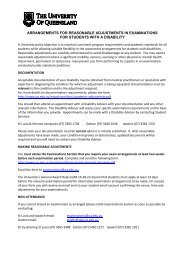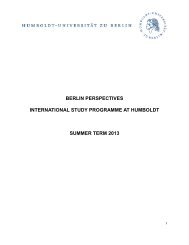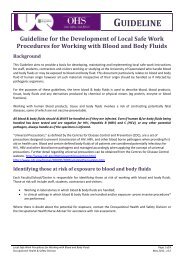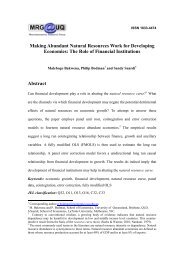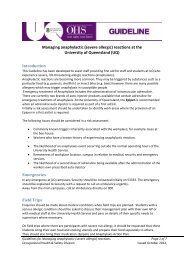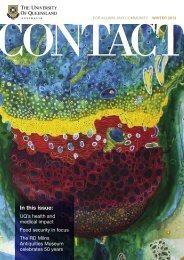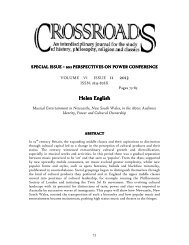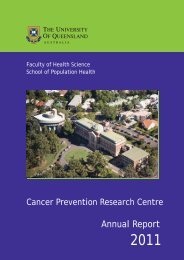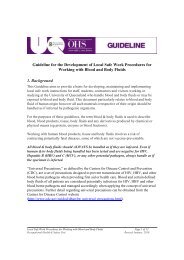Review of the Social Capital Literature - University of Queensland
Review of the Social Capital Literature - University of Queensland
Review of the Social Capital Literature - University of Queensland
You also want an ePaper? Increase the reach of your titles
YUMPU automatically turns print PDFs into web optimized ePapers that Google loves.
4.3 <strong>Social</strong> <strong>Capital</strong> and Housing Policy/Community DevelopmentLittle work has measured <strong>the</strong> impact <strong>of</strong> social capital on housing, and what littleexists tends to be placed within <strong>the</strong> community development literature. There ishowever increasing interest in this area, reflected in <strong>the</strong> 1988 publication <strong>of</strong> aspecial edition <strong>of</strong> Housing Policy Debate dedicated to social capital and housingpolicy. The quality <strong>of</strong> housing gains consideration by Saegert and Winkel, in <strong>the</strong>irassertion that social capital can be an effective component <strong>of</strong> locally sponsoredlow-income housing programs (Saegert and Winkel 1998). <strong>Social</strong> capital ismeasured at <strong>the</strong> level <strong>of</strong> <strong>the</strong> building, where it is seen to have greatest potentialfor effectiveness in improving housing quality and security. Their social capitalmeasure was based upon 14 items, eight <strong>of</strong> which inquired about residentinvolvement in <strong>the</strong> social and organizational functioning <strong>of</strong> <strong>the</strong> buildings, while <strong>the</strong>o<strong>the</strong>r six looked at residents’ assessments <strong>of</strong> <strong>the</strong> extensiveness <strong>of</strong> participation inbuilding activities by o<strong>the</strong>r residents. These were <strong>the</strong>n hypo<strong>the</strong>sised to describefour within-building social capital factors: basic tenant association participation,informal building organisation, leadership activity and perceived prosocial norms.Results showed that social capital was higher in tenant-owned co-ops andmediated <strong>the</strong> effect <strong>of</strong> ownership on building conditions. It was a more potentmediator in ownership forms that both nurtured and depended on social capital,<strong>the</strong>se mainly being tenant ownership and to a lesser extent, community groupownership. Overall, <strong>the</strong> study showed that alternative forms <strong>of</strong> ownership thancontinuing city ownership resulted in better building quality and safety (although itwas noted that substantial public investment would still be required).Moving from housing quality to neighbourhood, Temkin and Rohe (Temkin andRohe 1998) consider <strong>the</strong> affect <strong>of</strong> social capital on neighbourhood stability. Usingdata taken largely from <strong>the</strong> Pittsburgh Neighbourhood Study (1990), <strong>the</strong>y presenta model <strong>of</strong> neighbourhood change using two constitutive elements <strong>of</strong> socialcapital as explanatory variables, sociocultural milieu and institutionalinfrastructure. 5 <strong>Social</strong> milieu subsumes <strong>the</strong> concepts <strong>of</strong> social fabric and socialstructural characteristics <strong>of</strong> neighbourhoods. The construct included variablesdesigned to measure <strong>the</strong> following; <strong>the</strong> extent to which residents felt <strong>the</strong>irneighbourhood was spatially distinct, interaction with each o<strong>the</strong>r, whe<strong>the</strong>rresidents work and socialise in <strong>the</strong> neighbourhood, and whe<strong>the</strong>r <strong>the</strong>y useneighbourhood facilities. Institutional infrastructure measures <strong>the</strong> level and quality<strong>of</strong> formal organisations in <strong>the</strong> neighbourhood, and <strong>the</strong>se variables measure <strong>the</strong>level <strong>of</strong> voting activity, and <strong>the</strong> visibility and perceived effectiveness <strong>of</strong>neighbourhood organisations. Following initial analysis <strong>the</strong> statistically significantcompone nts, measuring political activity, neighbourhood loyalty and attachment,and whe<strong>the</strong>r <strong>the</strong> neighbourhood is a good place to live were summed to form <strong>the</strong>measure <strong>of</strong> social capital. The results showed that <strong>the</strong> two constitutive elements<strong>of</strong> social capital had positive and significant effects upon <strong>the</strong> measure <strong>of</strong>neighbourhood stability, suggesting that neighbourhoods with higher levels <strong>of</strong>social capital (as measured by greater degrees <strong>of</strong> a sociocultural milieu and5Analagous to Putnam’s notions <strong>of</strong> civic engagement and trust (Putnam, 1998: 62)February 2001 DRAFT ONLY 21


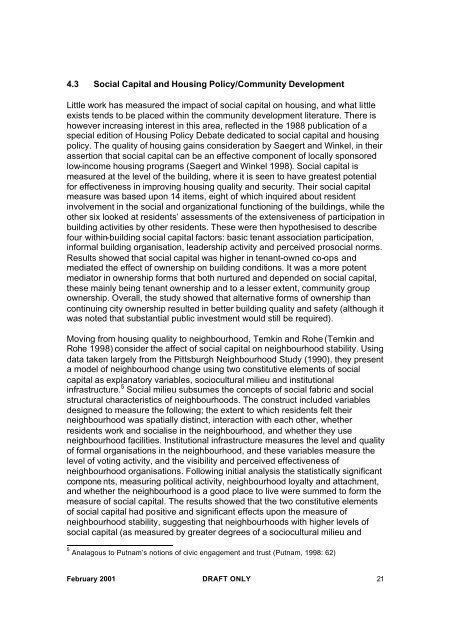

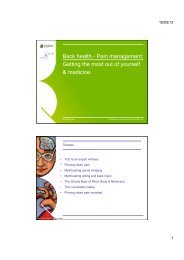
![Recycling [ PDF, 62KB ] - University of Queensland](https://img.yumpu.com/51805185/1/184x260/recycling-pdf-62kb-university-of-queensland.jpg?quality=85)
